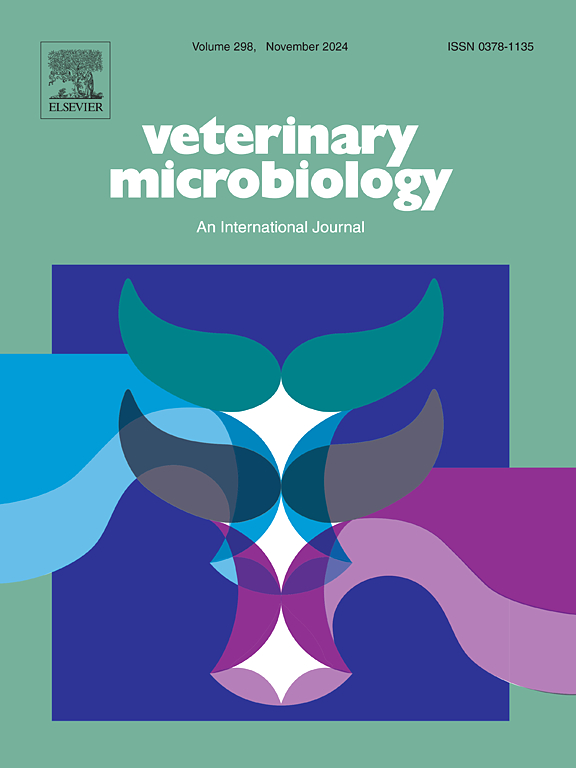PERK-mediated eIF2α phosphorylation suppresses porcine epidemic diarrhea virus replication by attenuating global protein synthesis and inducing IFN-Ⅰ production
IF 2.7
2区 农林科学
Q3 MICROBIOLOGY
引用次数: 0
Abstract
Porcine epidemic diarrhea virus (PEDV) is one of the most important porcine pathogens for which no preventive and antiviral treatment measures are available. A pervious study revealed that the unfolded protein response (UPR) induced by endoplasmic reticulum (ER) stress can be utilized to inhibit PEDV replication. Here, we demonstrated that the UPR suppresses the replication of multiple genotypes of PEDV in both Vero and swine testis (ST) cells, primarily through activation of the PERK-eIF2α branch among the three UPR pathways. The PERK-eIF2α pathway inducers CCT020312 and salubrinal efficiently inhibited the replication of multiple genotypes of PEDV in both Vero and ST cells, whereas the inhibitor AMG PERK 44 promoted PEDV replication. Furthermore, we found that PERK-eIF2α arm-mediated inhibition of PEDV replication is caused by phosphorylated eIF2α-induced attenuation of global protein translation. Additionally, phosphorylated eIF2α promotes NF-κB signaling activation and facilitates to the production of IFN-Ⅰ, eliciting innate immunity to suppress viral replication. These data show that PERK-eIF2α pathway dampens the replication of multiple genotypes of PEDV, suggesting that this target may be exploited to develop as a broad-spectrum anti-PEDV drugs.
perk介导的eIF2α磷酸化通过减弱全球蛋白合成和诱导IFN-Ⅰ的产生来抑制猪流行性腹泻病毒的复制
猪流行性腹泻病毒(PEDV)是一种重要的猪病原体,目前尚无预防和抗病毒治疗措施。先前的研究表明,内质网(ER)应激诱导的未折叠蛋白反应(UPR)可用于抑制PEDV的复制。在这里,我们证明了UPR主要通过激活三个UPR通路中的PERK-eIF2α分支来抑制Vero和猪睾丸(ST)细胞中多种基因型PEDV的复制。PERK- eif2 α通路诱导剂CCT020312和salubrinal在Vero和ST细胞中有效抑制PEDV多种基因型的复制,而抑制剂AMG PERK 44则促进PEDV的复制。此外,我们发现PERK-eIF2α臂介导的PEDV复制抑制是由磷酸化的eif2 α-诱导的全局蛋白翻译衰减引起的。此外,磷酸化的eIF2α促进NF-κ b信号激活,促进IFN-Ⅰ的产生,引发先天免疫抑制病毒复制。这些数据表明,PERK-eIF2α通路抑制PEDV多种基因型的复制,表明该靶点可能被开发为广谱抗PEDV药物。
本文章由计算机程序翻译,如有差异,请以英文原文为准。
求助全文
约1分钟内获得全文
求助全文
来源期刊

Veterinary microbiology
农林科学-兽医学
CiteScore
5.90
自引率
6.10%
发文量
221
审稿时长
52 days
期刊介绍:
Veterinary Microbiology is concerned with microbial (bacterial, fungal, viral) diseases of domesticated vertebrate animals (livestock, companion animals, fur-bearing animals, game, poultry, fish) that supply food, other useful products or companionship. In addition, Microbial diseases of wild animals living in captivity, or as members of the feral fauna will also be considered if the infections are of interest because of their interrelation with humans (zoonoses) and/or domestic animals. Studies of antimicrobial resistance are also included, provided that the results represent a substantial advance in knowledge. Authors are strongly encouraged to read - prior to submission - the Editorials (''Scope or cope'' and ''Scope or cope II'') published previously in the journal. The Editors reserve the right to suggest submission to another journal for those papers which they feel would be more appropriate for consideration by that journal.
Original research papers of high quality and novelty on aspects of control, host response, molecular biology, pathogenesis, prevention, and treatment of microbial diseases of animals are published. Papers dealing primarily with immunology, epidemiology, molecular biology and antiviral or microbial agents will only be considered if they demonstrate a clear impact on a disease. Papers focusing solely on diagnostic techniques (such as another PCR protocol or ELISA) will not be published - focus should be on a microorganism and not on a particular technique. Papers only reporting microbial sequences, transcriptomics data, or proteomics data will not be considered unless the results represent a substantial advance in knowledge.
Drug trial papers will be considered if they have general application or significance. Papers on the identification of microorganisms will also be considered, but detailed taxonomic studies do not fall within the scope of the journal. Case reports will not be published, unless they have general application or contain novel aspects. Papers of geographically limited interest, which repeat what had been established elsewhere will not be considered. The readership of the journal is global.
 求助内容:
求助内容: 应助结果提醒方式:
应助结果提醒方式:


